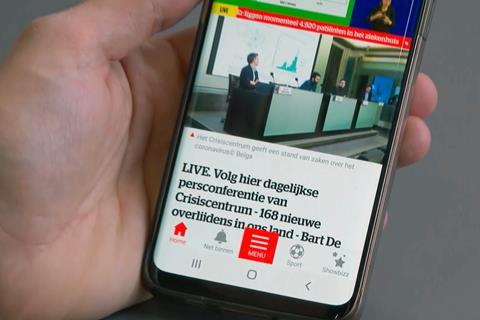The systems architect is continuing to explore new opportunities in the “digital environment”, CEO Peter Nöthen tells David Davies.

The prominence of the systems architect and ICT integrator Qvest Media has grown steadily worldwide. While headquartered in Germany, new offices have come online over the years across Europe, the Middle East Southeast Asia and Australia. In terms of technology innovation, Qvest Media has reinforced its vanguard role in cloud engineering and the development of software solutions such as the multicloud management platform qibb.
Even during the pandemic the company has grown further, with mid-July bringing the news that it had acquired digital agency dimensional GmbH. Formed in 1998, dimensional GmbH has built up a strong profile in both the media and healthcare sectors, and its acquisition brings significant expertise in multiple areas – among them digital prototyping and intuitive application-oriented UX design – into the Qvest Media organisation.
Explaining the thinking behind the purchase of dimensional, Qvest Media CEO Peter Nöthen remarks: “Our growth opportunities beyond the broadcasting and media industry lie in the digital environment and the holistic implementation of digital transformation processes through the development of individual software solutions. With the acquisition of dimensional, we have gained valuable expertise in digital prototyping, user interface design, user experience design, and the agile development of software solutions in areas such as cloud applications, digital asset management, multi-format content delivery, OTT, and, mobile apps.”
Along with making it easier to deliver front-end solutions and web applications that “simplify and accelerate workflows”, Qvest Media has also been devoting considerable energy to the expansion of its media software capabilities, with the qibb multicloud management platform proving to be a particular milestone. Intended to “pave the way for cloudification” in systems integration, qibb supports companies in the implementation of their cloud and IT strategies.

With the enterprise solution qibb ultimate, says Nöthen, “all software applications that are used in a company can be efficiently orchestrated, managed and monitored across local data centres, as well as multiple public and private clouds. The qibb platform adapts seamlessly to individual system and cloud requirements.”
Based on qibb, SaaS products for various tasks such as media production, media distribution, cloud playout and streaming, or cloud-based content archiving are offered to clients from the media and corporate sectors. Drawing on the company’s years of experience in cloud engineering, these solutions comprise “selected interlinked cloud applications from various manufacturers and can be started as a finished workflow in the cloud for clients in just a few minutes. In addition to advantages such as team collaboration and unlimited scalability, the cloud solutions offer many other benefits. “As SaaS solutions, we continuously manage and develop the products further for clients, and thanks to the flexible pay-as-you-go model costs are only incurred during use. Our cloud solutions are therefore suitable for permanent operation as well as for short-term capacity expansion for temporary or recurring events and productions.”
Technological transitions
Over the past few months there has been considerable industry discussion about the effect that the pandemic might have on certain technological trends. The transition from SDI to IP connectivity was already well underway before the pandemic and seems unlikely to be much affected by current events, but there is some reason to wonder if adoption of Next Generation Audio and HDR, for example, might be impacted by more straitened financial circumstances.
The reality is that, as Nöthen remarks, “it depends strongly on the perspective one takes. For instance, from the perspective of a classic advertising-financed linear broadcaster, one could assume that the pandemic is currently slowing down developments such as 4K and HDR due to reduced advertising revenues. However, if we consider that companies like Netflix and Amazon are heavily influencing and promoting technology ‘leaps’ such as immersive audio, we can come to a different conclusion because these technology giants are in great shape right now because of the pandemic.”
“We are consistently expanding our radius of action,” Peter Nöthen
Qvest Media itself certainly seems to have responded effectively to the challenge of Covid-19. The tendency of many clients to implement at least some degree of virtualised and cloud-based operation has made it possible to undertake a lot of consultancy and systems integration work remotely. Moreover, the demand for solutions that can improve corporate video streaming has been especially buoyant, and with the technology of streaming pioneers such as StriveCast – which is integrated with Microsoft Teams among others – Qvest Media has been “deploying innovative solutions that require only a fraction of the bandwidth for video streaming and make worldwide communication unlimitedly scalable, secure, stable and cost-effective.”

Al Mamlaka TV, Jordan
Qvest Media designed, built and integrated the complete infrastructure for the 24/7 news channel Al Mamlaka TV in Jordan which features three studios.
Headed by Independent Media Station (IMS), this channel is presently delivering news and broadcast shows, both on linear TV and OTT platforms. The fully redundant broadcast IT equipment works on virtualised systems and are managed by one central interface.
Also in the company’s favour is the fact that – in Nöthen’s words – “we are consistently expanding our radius of action”. Given this it’s no surprise to discover that machine learning and artificial intelligence are firmly on the company’s radar in the wake of initial use cases presented at IBC 2017 and an ongoing AI-based collaboration with a leading media university.
“The potential that these technologies offer for almost every stage in the value chain is enormous,” he confirms. “We can already see the first areas of application for the use of AI in media workflows, such as for editorial purposes in newsrooms, video analysis and evaluation, or the autonomous editing of video clips in sports. So it’s clear that this development will continue to progress rapidly and become increasingly important to the industry.”





























No comments yet